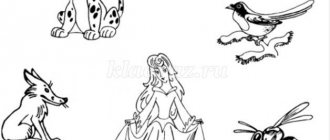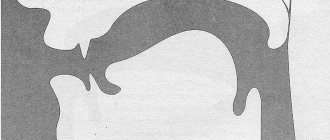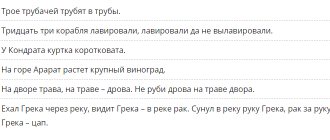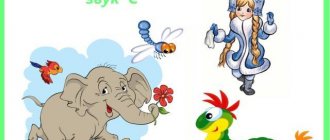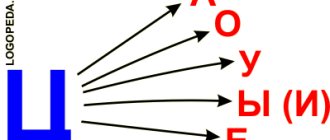Summary of an open lesson on sound automation [R]
Goal: Automate a clear pronunciation of the sound [R] based on the topic “Adventures with the robot Robik.”
Tasks:
Correctional and educational:
- consolidate the correct pronunciation of the sound [P] in isolation, in syllables, words, sentences, pure phrases;
- clarify the correct articulation of the sound [P];
- exercise the ability to determine the place of a sound in a word and connect an object with a diagram;
- consolidate the visual image of the letter [P].
Correctional and developmental:
- develop children's facial muscles;
- develop visual and phonemic perception, memory, thinking, fine, gross and articulatory motor skills, coordination of speech with movement.
Correctional and educational:
- formation of a positive attitude towards participation in the lesson;
- formation of goodwill, independence, initiative, responsibility.
Equipment:
- flat figures of the robot Robik and Kolya;
- drawing with an image of an umbrella;
- cards depicting emotions (robot);
- audio tracks;
- table with letters;
- game "Mountain Path" (playing field with cubes and chips);
- easel;
- table - a house with graphic diagrams showing the place of automated sound in a word;
- cards (automated sound at the beginning, middle and end of a word).
Progress of the lesson
1. Organizational moment Hello, my name is Robik! I am a little robot who came to Earth to learn everything that a person can do. I have a friend, Kolya, with whom I explore the world. I have already learned to express my emotions: smile, be sad, be surprised and even get angry. Pictures of emotions with a robot are hung on an easel.
And now I want to learn how to speak correctly. There are many different sounds in our language, and I really want to pronounce them clearly and correctly. I invite you to this wonderful world of sounds.
Finger gymnastics “Robot”
| A robot came to us today. | (clench and unclench your fists rhythmically). |
| Two arms, two legs, head in place | (knock on the table with their fists, feet on the floor, turn their heads, hands on their ears) |
| In the world of sounds he wants to play with us. | (rhythmically clench and unclench your fists, then clasp your hands, interlocking your fingers). |
Today we will repeat the sound [R]. How to form the sound [R] correctly:
- the lips are in the position of the next vowel;
- teeth at a distance of several millimeters;
- the tip of the tongue is raised to the alveoli, tense and vibrating; the edges of the tongue are pressed against the lateral teeth;
- there is an air stream in the middle of the tongue, which can be felt with the palm of the hand brought to the mouth;
- under the influence of a strong air stream, the tip of the tongue begins to vibrate;
- the soft palate is raised, pressed against the back wall of the pharynx, closing the passage into the nasal cavity, the air stream goes through the mouth;
- The vocal folds are tense, brought together and vibrate, resulting in the formation of the voice.
The position of the tongue behind the upper teeth and the vibration of the tip of the tongue are visually controlled. Tactile warm intermittent stream. In order to pronounce it correctly, you need to perform special exercises for the tongue.
Articulation gymnastics
“Doors open”, “Pancake”, “Horse”, “Mushroom”, “Swing”, “Focus”, “Painter”, “Machine gunner”.
2. Isolated pronunciation of the sound “R”.
"Soundtracks".
On my planet, we robots love to draw sound tracks. Draw a line along the path without lifting the pencil from the sheet, pronouncing the sound (r-r-r-r-r-r) with one exhalation.
3. Consolidating the visual image of the letter R. Development of visual perception.
"Find the letter." Find and circle all the letters P, while clearly pronouncing the sound [P].
4. Automation of sound in syllables.
The friends decided to go on a hike and began to collect the necessary things. Help Robik and Kolya fix their umbrella in case of rain.
"Fix the umbrella." Connect the letters P in the picture only with vowels. Read the resulting syllables, clearly pronouncing the sound [R]. Umbrella drawing. 5. Development of phonemic hearing.
Game "Catch the Sound".
Robik and Kolya want to offer you a game. Catch the sound. I will name the pictures, and if you hear the sound [P], take this picture in your hands, or clap your hands. 8-10 pictures are laid out on the table.
6. Automation of the sound “R” in words.
“Pack a backpack for your friends.” They need to take with them only those items whose name contains the sound [P]. Name them, don’t forget to pronounce the sound [R] correctly. Cards
7. Coherent speech. Automation of sound in a sentence.
"Seen on the Road"
Robik and Kolya saw a lot on the road. Choose a picture and make a sentence with it. Pictures are displayed on the easel.
Physical school
The robot is standing on the road, the movements are performed according to the text. His legs do not bend, He can wave his arms, He can blink his eyes, He can nod his head, One, two, three, four, five.
8. Automation of the sound “R” in words and phrases.
During the trip, the friends had to climb to the top of a high mountain. To do this, they had to overcome the “Mountain Path.” Help them cope with the task of naming all the pictures encountered along the way.
Description of the game.
Players roll the dice and determine who goes first. The first player takes as many “steps” as there are dots on the die. Once in the appropriate circle, he names the pictures above and below the circle and in his voice emphasizes the sound [p] in the names of the objects. If each word contains the sound [r], the player can make another one - a bonus move. If only one word contains the sound [r], the player remains on the same circle where he was, and the turn passes to the other player. If there is no sound [r] in more than one word, he returns back to the start and starts the game again.
Game "Mountain Path".
Pure sayings are repeated together by two players in the corresponding pictures.
Start Ra-ra-ra - the game begins (at the start). Ro-ro-ro we will go far (picture of a bus and a rose). Ru-ru-ru I see a kangaroo (picture of a kangaroo and a shirt). The fish - the fish - got to the wasp (picture of a wasp, a sparrow).
Finish RA-ra-ra is an interesting game (at the finish line).
9. Determination of the place of sound in a word.
On the trip, they met Carlson and became friends. Carlson asked his friends to complete the task. But it turned out to be difficult for them. Please help them cope. The child is shown a table of a house consisting of three “entrances”. Each “entrance” has 3 “floors”, and on top (in the attic) there is a graphic diagram showing the place of the automated sound in the word (sound at the beginning, in the middle and at the end of the word). The child must arrange all the pictures into their “apartments”. Then ask the speech therapist to name all the pictures in which the sound is at the beginning of the word; in the middle of a word; at the end of a word. Name what is shown on the cards.
Cards (rose, robot, cancer, cake, thermos, pencil, tomato, cheese, axe).
10. Development of auditory attention and memory.
In the evening before going to bed, friends decided to learn to write poetry. Try it too. Complete the word and repeat the entire sentence. Children are offered the riddle game “Give me a word.” A picture is hung on the easel (hint).
He is tall like a closet, and his name is... (giraffe). Luda looks in surprise at the humpbacked... (camel)
This is such a miracle garden, we stand open-mouthed... (mouth).
In the severe cold in January, the Hedgehog sleeps in his ... (hole).
On the porch at the gate, the red one meowed.....(cat).
11. Homework: learn the poem “Robot”
There is no steering wheel and no tires, But I am a relative of cars. Even though I have a square head, I’m almost like you, alive: I stand and I walk. Whoever wants to, I’m friends with him. I may be a little stubborn, but I am a very kind robot.
12. Summing up.
Well done, you tried very hard today, so you clearly and clearly pronounced the sound [R] in syllables, words, and phrases, and you taught this to our guests. Our guests are grateful to you. Now watch your speech and don’t forget about the sound [R].
Author of the material: Gordienko Olga Leonidovna
Also on topic:
Summary of an individual lesson on the topic: Automation of sound [R]
Summary of an individual speech therapy lesson on sound automation [R]
author: Balok Inna Igorevna
Teacher-speech therapist GKOU LO Luga boarding school
Summary of an individual speech therapy lesson on sound automation [R]
Summary of an individual speech therapy lesson on sound automation [R]
Target:
automation of the sound [P] in syllables, words, sentences.
Tasks:
Educational:
- Practice correctly pronouncing the sound [P] in syllables, words and sentences;
- Formation of diminutive forms of nouns;
- Formation of nouns denoting names of professions;
- Know articulation exercises;
- Know the articulation of the sound P and its characteristics;
- Be able to determine the place of the sound R in words (at the beginning, in the middle, at the end);
- Know the graphic image of the letter P;
Educational:
- Develop phonemic awareness
- Develop skills in sound analysis and synthesis
- Develop holistic perception
- Development of fine and gross motor skills.
Educational:
- Fostering the desire to master correct speech;
- Cultivating positive interest in speech therapy classes
Health saving:
- Preventing student fatigue.
- Prevention of poor posture.
Equipment:
Cut-out picture “Bus”, cards with numbers 2 and 3, toys: a dog, an elephant, three “pedestals” (multi-colored cubes), pictures with the sound [P] at the beginning, in the middle, at the end of the word, mosaic, wall mirror, ball .
Progress of the lesson
- Organizing time.
– Today you and I will go to the circus. An interesting performance awaits us.
- Articulation gymnastics.
– But before you go to the circus, you need to develop a tongue.
- Exercise “Brushing your teeth”
1.Smile
2.Show teeth, open mouth slightly
3. Using the tip of your tongue, alternately “brush” the lower and upper teeth
- Exercise "Drummer"
1.Smile
2.Open your mouth
3. Tap behind the upper teeth with the tip of your tongue, pronouncing the sound D: d-d-d (slowly at first, gradually speed up the tempo). The lower jaw is motionless. (You can try to create an artificial vibration of the tongue with a cotton swab under your tongue while frequently saying d-d-d).
- Exercise "Painter"
1.Lips in a smile
2.Open your mouth slightly
3.Stroke (“paint”) the palate with the tip of your tongue, moving your tongue back and forth
- There's a stop ahead. What can you drive to the circus? Collect the picture and you will find out what we will ride on to the circus. (The child assembles a picture “bus” from parts).
- So what will we go on?
- By bus.
- Start the engine! Go! “The motor growls R-R-R...” (The child pronounces the sound [R] loudly).
- Sound characteristics [P].
-What sound are we making? What is the sound [R]?
– Consonant, hard, voiced, indicated in blue, with the letter P.
- Sound automation.
1) in syllables
- Here we are at the circus. What kind of artists do you think work in the circus? (Child's answer)
The performance begins. Trained dogs perform.
- They know the numbers: they tell them the number, and the dogs bark the same number of times.
– I will pronounce the syllable, and you repeat it, the number of times corresponding to the number:
pra – 2 doubles – 3 pairs – 2 pairs – 3
- Well done!
2) in words
– A clown is performing in the arena. It tries to show focus:
turn large objects into small ones. Shall we help him?
- Yes.
- A big bucket, and a small one... a bucket, a box - a box, a cake - a cake, a tomato - a tomato, a picture - a picture, a pencil - a pencil, a shirt - a shirt.
3) in sentences
– What do you think a clown does in the circus? (Child's answer) The clown makes children laugh at the circus, so he wants to make you laugh too.
– Listen to whether he speaks correctly and correct mistakes if necessary.
Ball game “It happens, it doesn’t happen”
- An ax is used to chop wood.
– Sugar is gnawing at Ira.
- The road goes along the truck.
- Development of phonemic hearing. Formation of nouns denoting names of professions.
– During the performance, the circus orchestra plays loudly.
- Let's see what tools it has. Name the instruments whose names contain the sound [R]: drum, trumpet, piano, guitar, tambourines, accordion.
- Well done! Named the tools correctly! What do we call a person who plays the harmonica? Please answer with a complete answer. (Harmonist)
- Dynamic pause
– If we play the harmonica, who will we be? (Imitation of playing the harmonica)
We play the harmonica
Let's clap our hands loudly!
We shake our heads slightly,
We raise our hands up!
- Position of sound in a word.
- And the show continues at this time. A trained elephant enters the arena.
– On command he needs to take one of the three stands. The command for him is a picture. If the sound [P] is at the beginning of the word, the elephant will stand on the first pedestal, if in the middle - on the second, and if at the end of the word - on the third pedestal. The speech therapist shows pictures (daisies, mosquito, fish, ram, fence, cow)
(The child names the picture, determines the place of the sound in the word and places the elephant on the correct stand).
- Exercise in correctly pronouncing the sound [R].
- The show ends. The artists say goodbye to the audience.
Irk - irk - irk - everyone loves the circus.
Ry - ry - ry - balls in the hands of children
Ra - ra - ra - goodbye, kids.
Great, great, great, it’s time for the artists to rest.
(The child pronounces pure phrases after the speech therapist).
- Fine hand motor skills.
-When saying goodbye, the artists gave us a mosaic, let’s use mosaic tiles to lay out the letter R.
- Summary of the lesson.
- It's time to go home.
– Tell me, which artists’ performances did you like? Please answer with a complete answer.
– What sound did we take with us to the circus?
(Child's answer). Summary of an individual speech therapy lesson on sound automation [R]

